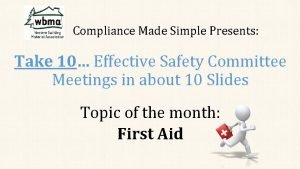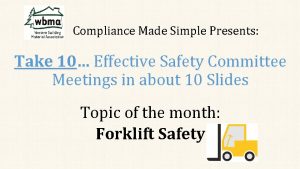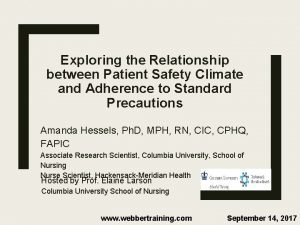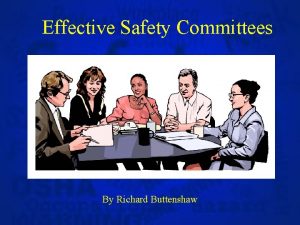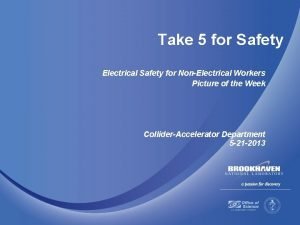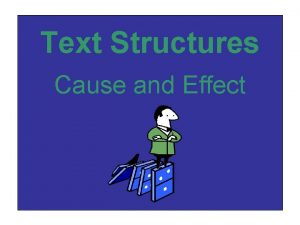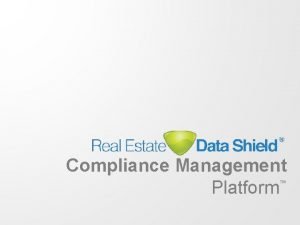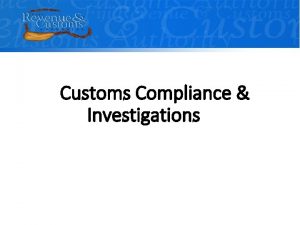Compliance Made Simple Presents Take 10 Effective Safety











- Slides: 11

Compliance Made Simple Presents: Take 10… Effective Safety Committee Meetings in about 10 Slides Topic of the month: Forklift Safety

First things First: Document Your Meeting Per Your States Requirements Washington Oregon Montana Alaska & Idaho: There are currently no federal and/or state-specific requirements for safety committees in these states.

Why forklift safety matters… • About 100 workers are killed in forklift related accidents every year in the United States; while • 20, 000 workers are seriously injured in forklift related accidents every year in the U. S. A; and • 34, 000 injuries are treated in Emergency Rooms every year due to forklift accidents. Note: Reviewing actual/recent accidents is a proven effective method for getting employee buy -in with safety measures. To view recent forklift related accidents, open OSHA’s Weekly Accident/Catastrophe Reports. Then, type “forklift” in the Hazard Description filter tab.

The Top Causes of Forklift Accidents • Tipping Over – Carrying an excess load can cause a forklift to tip over, often crushing construction workers in the path of the overloaded material, or crushing the forklift driver if a “Roll Over Protection System” has not been installed. Tipping over accounts for 42% of all forklift related fatalities • Falling Debris • Driver Ejection – The driver seats should be equipped with seat belts, arm rests, and grab handles. • Hitting Pedestrians • Elevating Workers – A forklift is not intended to be used to elevate workers, who may fall if an operator losses control. • Unsafe Driving Conditions – Low visibility, narrow or congested pathways, obstructed intersections are all unsafe conditions to drive in.

Top 5 Forklift Related Citations 1. Failure the of the business to follow training requirements 2. Failure to wear a seatbelt 3. Failure to inspect for defects 4. Modifying the forklift without manufacturers approval 5. No nameplate or forklift nameplate is unreadable

Identifying Forklift Hazards Some factors to consider include: • Forklift Capacity: can your forklift handle the size and weight of your load? • Does your load feel top heavy or awkward in any way? • When is the last time you looked at the condition of your forklift? Are the forks damaged? Can you identify any other mechanical problems with your forklift that could lead to an accident? • Have you and/or any of your employees complained of obstacles, bumps, potholes, people regularly passing, etc. that the safety committee should address?

Are you required to wear your seatbelt? Yes… OHSA's enforcement policy relative to the use of seat belts on powered industrial trucks is that employers are obligated to require operators of powered industrial trucks which are equipped with operator restraint devices or seat belts to use the devices. OSHA will enforce the use of such devices under Section 5(a)(1) of the OSH Act. While the Occupational Safety and Health Act does not specifically require the use of seatbelts, Section 5(a)(1) of the OSH Act requires employers to protect employees from serious and recognized hazards. Federal OSHA and state programs have thus interpreted the use of seatbelts to be a requirement. Did you know: About 1/3 of all forklift fatalities are the result of the fork tipping over and pinning the operator between the ground and the forklift.

Are we properly servicing & inspecting our forklifts? Daily inspections of your forklift (including documentation that its been done) are required by OSHA as well as each individual state plan. Failure to do them could result in a citation and/or a preventable Injury to employees. What are ways we can promote employees doing daily forklift inspections? : One idea a lumberyard once tried was to put a note on the oil dipstick stating that the first employee to bring it to management would get a free day of vacation. Sadly after 6 months, not one employee had claimed the prize. Nonetheless, this provided valuable information on an area to focus on.

Proper Fueling Procedures: Are we… • Prohibiting Smoking or Use of Open Flames? • Shutting off the forklift before fueling? • Preventing overfilling the tank? • Cleaning up any spills right after they happen? • Regularly checking for leaks/cracks in fuel line? • Requiring and using eye protection while fueling?

Basic Forklift Safety Practices to Revisit with all Yard Employees • Use seat belts. They will keep you secured in the seat in the unplanned event of a tip over. • A parked forklift should have the forks flat on the floor with the controls set to neutral and with the parking brake set. • Remember, a forklift is considered to be "unattended" if the operator is more than 25 feet away or if the forklift is out of the direct vision of the operator. Unattended forklifts should be parked with the power turned off. • When operating the forklift on inclines, the load should always be on the uphill side of the incline. Drive forward going up the incline. Drive backward going down the incline. • When traveling without a load on the forks, keep the forks approximately four to six inches off the ground. • Never allow anyone to walk underneath a raised load. • Stop at all blind corners to check for other traffic in the area. This includes other forklifts and pedestrians. Honk your horn and look before you continue. • If carrying a tall load that blocks your forward vision, drive in reverse and turn your head so you can see where you are going. • If operating around other forklifts maintain a three-forklift length distance between forklifts and never attempt passing. • Never drive a forklift up to the back of a person who is unaware that the forklift is behind them.

Resources: OSHA Safety & Health Topics: Powered Industrial Trucks (Forklifts) OSHA Powered Industrial Trucks (Forklift) e. Tool Washington Forklift Safety Guide Oregon OSHA Forklift Safety Guide WBMA Forklift & You Training Resources Forklift Safety Video: 8 Rules to Avoid Accidents/Injuries (3: 28)
 Compliance made simple
Compliance made simple Compliance made simple
Compliance made simple Compliance made simple
Compliance made simple Shcedules
Shcedules How many elements does an effective compliance program have
How many elements does an effective compliance program have Take a bus or take a train
Take a bus or take a train National safety compliance quiz answers 11-013
National safety compliance quiz answers 11-013 Effective safety committees
Effective safety committees Effective safety committees
Effective safety committees Take 5 electrical safety
Take 5 electrical safety Rainbow cause and effect
Rainbow cause and effect Presents from my aunts in pakistan
Presents from my aunts in pakistan

